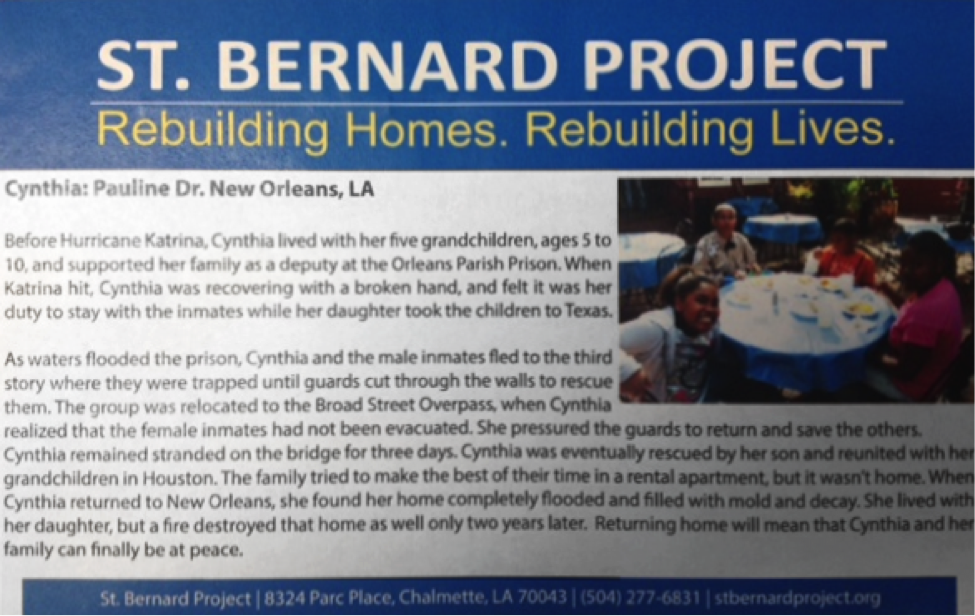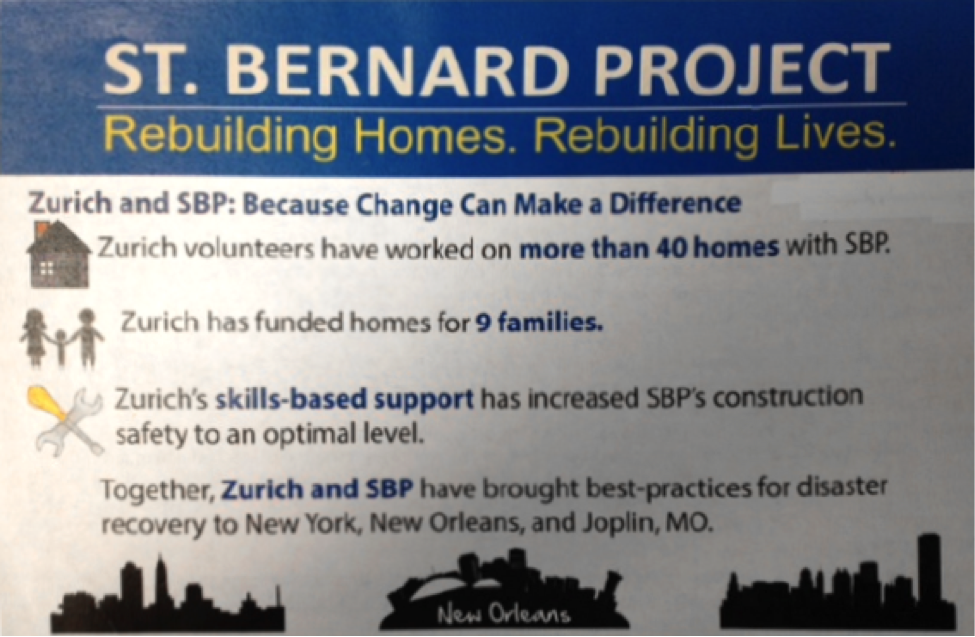With few staff and limited resources, it’s important to leverage the power of technology as much as possible.
Salesforce is a cloud-based customer relationship management (CRM) system that is easily modified for use in the nonprofit sector. Most importantly, the Salesforce Foundation’s Power of Us grant program provides 10 free Enterprise Edition user licenses to new nonprofit Salesforce users, a value of $15,000. Off the shelf, Salesforce is designed to track leads, contacts, organizations and sales. By installing the nonprofit starter pack, the system is easily modified to track information relevant to nonprofits such as donors, households and donations.
SBP has further developed its Salesforce environment to track volunteers, clients and construction projects using Salesforce’s custom, object functionality and drag-and-drop tools – no coding experience required.
A properly configured Salesforce environment allows for the tracking of
It’s important to have a publicly facing website for volunteers to register, clients to apply and constituents to donate. Salesforce integrates into HTML websites through Force.com sites, but uses a specialized markup language that has a steep learning curve. Organizations can mitigate this by using an online form submission tool that integrates into the Salesforce API such as Formstack.
Formstack is an online form creation tool that interfaces with many popular database systems including Salesforce. It provides publicly facing, hosted and embeddable forms that let volunteers register to serve, residents to express interest in services and donors to donate – all fed directly into Salesforce or the database of your choice.
Google Apps for Nonprofits provides free web-based email, cloud storage and a collaborative office suite to nonprofits with fewer than 4,000 users.
Why use social media? Put simply, because it works. According to Forbes magazine, and “The Pew Internet and American Life Project”, more than half of Americans own a smart phone, this puts them in touch with the world and social media all day, every day. Social media has quickly become an avenue that allows groups to reach a larger base of contributors than ever before. A properly established, nurtured and interactive social media program can bring in additional funding through donations and more volunteers for the rebuild project.
Social media should be used to expand the donor and volunteer base of your organization. The purpose of a properly run social media plan is to allow your organization to deepen its relationships and engage with more people across the country and even throughout the world. While this possibility didn’t exist years ago, venues like Twitter and Facebook can allow a nonprofit organization to better facilitate, collaborate and crowd source. Visibility can be rapidly increased through interactive social conversations.
Bitly
Bitly.com is a site that allows you to shorten a weblink to post in a Twitter or Facebook feed. The system allows you to track and analyze the use of the links and improve social media traffic.
Bufferapp.com
Bufferapp.com is another scheduling device for your twitter feeds. The app allows you to post information throughout the day to your social media sites without having to be in each account or be in the account throughout the day.
Craigslist
Craigslist is an online network that features free advertisements with dedication sections to almost any subject.
Easily Do
An app which allows you to sort through and respond to email, tweets, Facebook posts, etc. without having to access the accounts individually.
Facebook
Online social networks where users register, create a profile and build a network of friends. Facebook has more than 1 billion followers and active users.
Flickr
A method to share and organize photos, photos can be posted to Twitter or Facebook.
Foursquare
Foursquare is an app that allows users to check in at various locations, and it provides recommendations on other places you may want to visit. One can build a platform within Foursquare to act as a personal social service.
Google+
A social networking site similar to Facebook.
Hootsuite
A website that allows you to control and update multiple social media sites, such as Twitter, Facebook, etc. at one time. Hootsuite is free for up to five social profiles, the price starts at around $9 a month beyond that. The site allows for scheduling messages to be posted at various times, when the user may not be able to access the system to post.
Instagram
Method used to share pictures and videos. They can be linked to Facebook, Twitter, Tumblr and a variety of other media.
LinkedIn
LinkedIn is a social networking site that is focused on professional networking.
MySpace
A formerly popular social media site similar to Facebook, but with a bigger focus on music.
Pinterest
Pinterest acts as a bulletin board where individuals can post things they are interested via a picture. The Pinterest member views a photo and they can like it or post it to their board, which allows their followers to view it as well.
Pump.io
A micro blog site similar to Twitter.
Tout
An app that allows you to share video (up to 15 seconds) via Twitter, Facebook, or Linkedin.
Tumblr
Tumblr is a method of short-form blogging that allows for the posting of text, images, videos, etc.
Twitter
Twitter defines itself as a real-time network that connects you to the latest stories, ideas, opinions and news. It provides access to the voices and information surrounding your interests.
Twuffer
A scheduler that allows you to set up tweets for set dates and time.
Vine
A program that allows you to share a short, six second or less, video on Twitter.
WordPress
This is an online content management system that started as a host for blogging.
YouTube
A popular method by which one can share video clips.
Blogging: A method of discussion published on the Internet, made up of posts by one or multiple bloggers. A blog may be about one specific topic or it may be updated daily to cover a range of various thoughts on the part of the writer.
Branding: A method of advertising by design that promotes your company and leaves a specific image or concept in the consumer’s mind.
Crowdsourcing: The practice of obtaining needed services, ideas, or content by soliciting contributions from a large group of people, and especially from an online community, rather than traditional employees or suppliers (Merriam-Webster Dictionary).
Hashtags: Hashtags (#) are used to group messages, they provide an easy method to search for messages, groups, events, etc. They are a form of a metadata tag.
Metadata or metatags: A method used to tag specific information within your statement or picture. You can tag information in blogs, photos, events, etc.
Microblogging: A smaller, condensed form of blogging.
Tagging: You can tag a person or a subject in a post, tagging simply means you adding a label to the item or photo.
Tweets: Small messages less than 140 characters long, quick blurbs or sound bites.
Twestival: Also known as “Twitter Festival”, allows for the use of social media to develop and organize off-line events, this can be a great method to raise funds or set up in-person fundraisers, etc. for your organization. twestival.com/faq
Viral: Something that quickly becomes popular through sharing via social media sites.
Once you have established an email address for your group, you can set up a Facebook page, Twitter page and a Hootsuite account. You can add any other accounts that you feel would be helpful such as a Instagram, Vine and Google+.
Post as soon as possible, tweets are limited to 140 characters, but you can link your tweets to posts on your Facebook page. If you do this you will want quick soundbites to be in those first 140 characters. You can use a bitly to share and track links to articles and your website as well.
It’s important to remember that social media is today’s form of word of mouth. Prior to social media, people learned about everything via the news or their friends. In today’s connected world, social media has become the platform for spreading information about what people encounter.
Make sure your social media is an active, interactive, conversation between your group and the followers you have. The social media design should provide an experience to everyone. Update with notes regarding the status of various client homes, this will allow your volunteers to see the conclusion of homes they worked on and see families return as part of their hard work.
Ensure you focus on building your community and your volunteers and donors will be key in this aspect. You should talk to all of them about liking your page on Facebook and following your group on Twitter for updated information and more volunteer or donation options.
Social media can also be used to seek out and find new clients as well as post job openings. Take every opportunity to tweet data regarding your organization and events that are going on. Statistics on how many people have been brought home, or how many are still without a home can also be valuable information to provide to your followers.
Timing is imperative when using social media. Be sure to schedule posts for the weekend and always follow up on comments whether they are positive or negative. Use pictures and video as often as possible.
Hashtags(#) allow you to broaden your qualified audience by emphasizing key words in your comments.
Criticism must be responded to via the social networking medium that it’s posted on. This does not mean you should get into a public argument with the individual, but you do need to let everyone know you are attempting to address the issue. Simply deleting the complaint from your page or feed gives the appearance of censorship or stifling the opinions of others. Responding to the complaint demonstrates you are willing to accept and want as much feedback as possible.
Should you post your response publicly, be sure that the response is well written and poised, you do not want to come off sounding defensive. Try to remain focused on the originator and attempt to seek a remedy via that person first and foremost.
When there are news items or other recovery posts and articles that relate to your group, always post those or re-tweet them via your social media venue.
Grow your social media following organically, meaning that you obtain followers, they retweet what you have to say and more people start to follow and retweet your posts. The cycle will continue and these followers will be more loyal to your cause as a result.
Focus on your community and make sure the content you are posting is profound and inspiring, so your viewers and followers have the desire to share the information and pass it on to others with the same interests.
You have to be real, be humble, while also being profound and heartfelt so you can have others tell your story for you.
Twitter can be a great place to thank donors and volunteers, below are some examples of tweets:




This was the following day with:

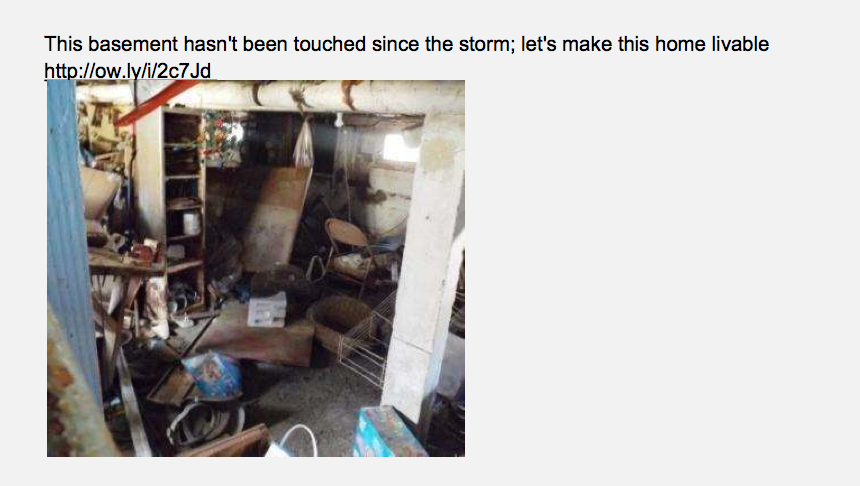











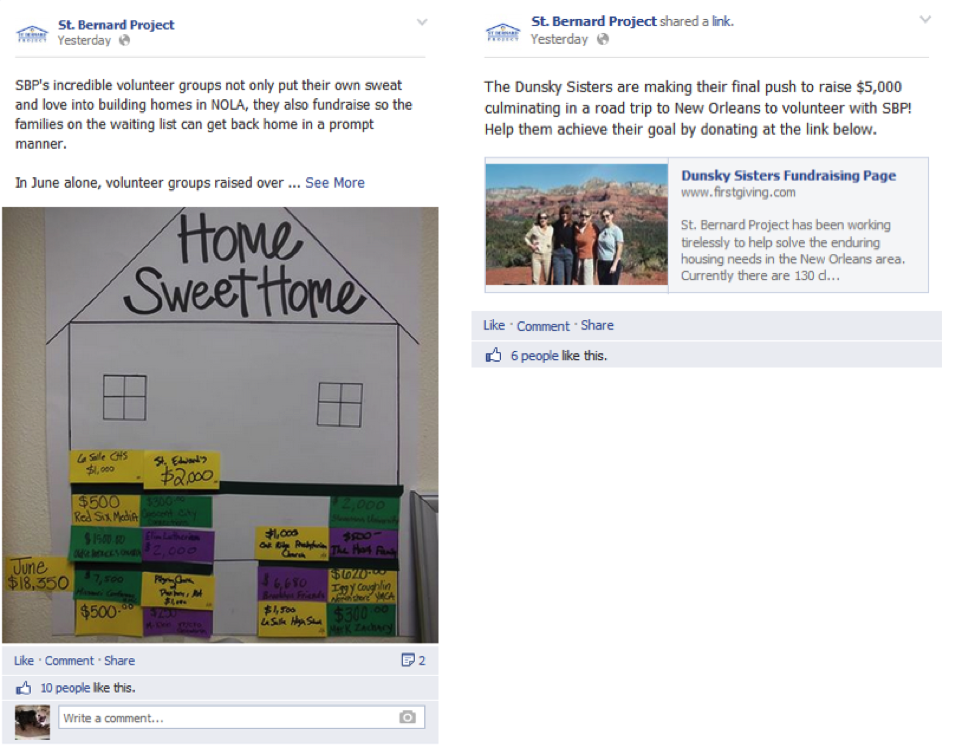
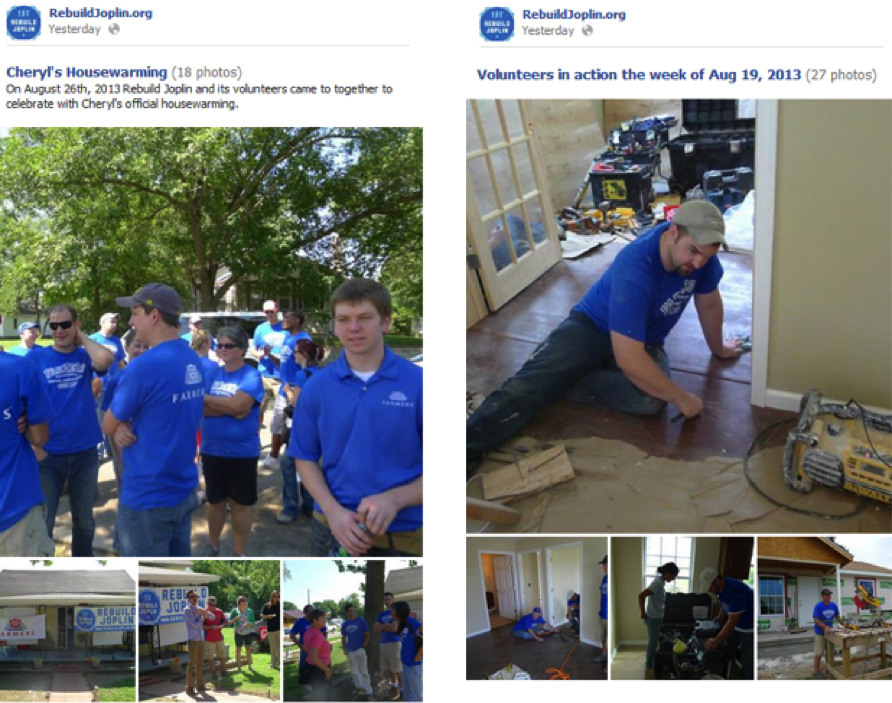
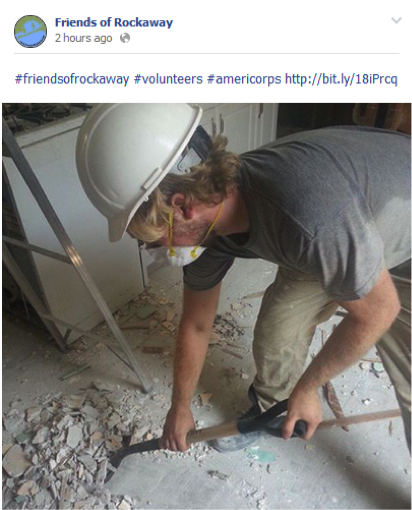
Building an effective media relations program will help you effectively tell your story and get your objective out to a target audience that will absorb the information and follow up with volunteers and donations.
The purpose of a solid media plan is to establish specific guidelines for speaking and dealing with the media. The ability to use the media for public acknowledgement will increase donations, other funding and volunteers.
A basic media relations plan will consist of three key players – The Sender (your organization); The Transmitter (the media); and the Audience (grantors, donors and volunteers). It’s imperative you build solid relationships with the local media as soon as possible.
To start your plan you need to answer the following questions
You must develop talking points and soundbites that will allow you to easily relay your message to the audience, this should be a part of your media plan. Anyone who may speak to the media should be well versed in these talking points. The plan must be straight forward and simple, so it can be easily communicated to volunteers as well as staff.
A talking point is a short sentence, maybe 10 words, that quickly explains the most important part of your message. When creating talking points, you need three statements that you can replicate over and over in your message to explain the theme of your story, what problem exists and how you plan to solve it. Within your talking points you should also have short phrases (underlined below) that say more than what the actual words in the phrase are. A good way to organize your talking points is chronologically:
These statements open up the reader or listener to want to learn more, they must captivate and intrigue them. These points will then be repeated throughout the remainder of your speech or press release. The key is to not directly repeat them but plug them in subtly so that the point continues to get across while not sounding robotic.
Press releases can be an excellent source of free media engagement. A press release appeals to reporters/editors because they are very busy and need facts fast. When prepping your media release, prepare your message points ahead of time so you can use them while writing the release.
Your press release should be structured as follows:
Headline: The headline should be succinct, to the point, bold and may be best written after the press release is complete. It’s imperative you ensure your grammar is accurate especially in the headline.
Body: You need to write the body of the release exactly as you would like to see it in print, most likely the editor who reviews it will simply copy as is. Since they will not have time to write up a completely different release.
Just the facts! Keep it to the event, people involved, etc. but factual information only.
Conclusion: This section needs to include information on your organization including: name, address, contact information, website, Facebook and Twitter handle.
Client biographies (client bios) are brief snippets of information regarding the client and their experience. The bio is essential to the volunteer experience and is also useful when seeking donations and funding. The bio includes a map to the location of their property and a photo of the client.
The purpose of the client bio is multifaceted:
Once selection is completed, the client service administrator completes the client bio and provides it to development for review and processing. The bio is then provided to volunteer services. This process relieves the client of the need to explain their story over and over again to members of your organization.
When completing a client bio, it’s important to remember this information will be given out to members of the public and many people will see it.
Always remember to consider what information you would want readily available to strangers, and that it does not violate any agreement with the client.
Specifically the following items should never be entered into a bio:
The client’s bio should include general information about the client, what is going to be done to their home and their story from the disaster.
Specifically you should include the following:
Option 1
Client A bought his/her home on ______ street in ____. He/She has always love the area and worked as a _______ for _______ until the day of (the event). Client A was _______ when the ______ struck.
He/She _______ and found a safe place to stay in the immediate aftermath. Client A was only partially covered by his/her insurance and hired a contractor to complete the minimal but necessary work on the home. The contractor required full payment up front and never completed any work on the home.
Client A moved in with relatives and has been residing there since, after being turned down for assistance from ____. Client A’s home requires a full rebuild due to the extent of damages suffered after the storm. Client A is excited to move back into the home that they have lived in for so long, this will give him/her a sense of closure and relief to be back in his/her own home again.
Option 2
Lived in ____: Client A has lived in _____ their entire life.
Occupation: Client A works at a family owned business in town, _____, which has been around since ____.
Relatives: Client A’s family mostly lives and works in ______, this includes parents, sisters, brother and cousins. He/She lives with his/her ___ and ___ children.
Project type: _______ (Major/Minor) repairs.
Currently living: Client A and family are currently living ______.
Setbacks in rebuilding: Enter the clients story of their rebuild here, this may include contractor issues, fraud, lack of insurance, etc.
Event experience: Tell the story of their experience during the event. Event should be replaced with the type of event, i.e. Tornado experience, Hurricane experience, etc.
Goals/hopes for the future: What plans does the client have past the rebuild of their home and life.
Reverse side The reverse side of the document can be tailored based on the group you have coming in. Often the reverse side has a map and directions. However, if you have a large group coming in, you may want to include some facts about the group (this example is displayed below).
Here are two examples of bios printed out for a corporate sponsor in New Orleans.
